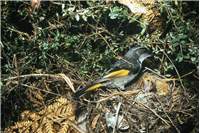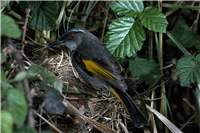Family
Meliphagidae
Genus
Phylidonyris
Species
pyrrhoptera
Threats/Control Methods - Regional
This species is vulnerable to many threats. The quality of the alpine forests in which it depends upon for breeding is declining due to weed infestations, severe bush fires, drought and land clearing. Predation by feral animals also poses a threat. Breeding success is limited by the long-term nature of partnerships and territories, as breeding will end if one partner dies or if the territory is destroyed. Honeyeaters may contribute to spreading weeds throughout native forests if native flowering species are not available to eat.
Threats/Control Methods - Local
Any birds leaving the ANBG and heading for the suburbs are instantly under threat of predation by local Cats (Felis catus).
Local/Urban Actions
Gardeners is suburbs where any honeyeaters are likely to visit can replace introduced plant species with flowering natives such as grevilleas, as this will encourage birds into the suburbs without the risk of spreading weeds into surrounding bushland. Cat owners can prevent predation by providing a stimulating indoor environment and an outdoor cat enclosure for their pets.
Common Names
Crescent Honeyeater, Chinawing, Egypt, Horseshoe Honeyeater
Distinguishing Features
The Crescent Honeyeater is 15-16 cm in size with a typical honeyeater downward curved beak and a long, slender body. The male's head and back is a dark grey colour, with bright yellow patches through the wings and tail. The underparts are light grey and streaked, and a thick dark band (crescent) reaches across each side of the breast, with a white line underneath. Eyes are dark red with a white brow. The female is similarly patterned and is pale brown-grey with smaller and duller yellow patches. Young birds are dull and lack the crescent band across the breast.
Survey Techniques
Call and visual identification.
Species Call
A loud 'tee-chiep', a high, musical 'tcheip-tcheip', or a rapid 'chip-chip-chip' alarm.
Similar Species
Both the New Holland Honeyeater (Phylidonyris novauhollandiae) and the Yellow-faced Honeyeater (Lichenostomus chrysops ) are of similar size, shape and colouring. However, the New Holland species is blacker with a white eye and the Yellow-faced species is so named for its distinct yellow face and blue-grey eye.
Distribution
This species is only found in the very southern regions of eastern Australia, from Sydney, south across to Adelaide and throughout TAS and surrounding islands. Locally, Crescent Honeyeaters inhabit the ranges to the west of Canberra and have colonised the ANBG.
Country of Origin
Australia
Conservation (Pet/Pest) Status - Regional
Population numbers have fluctuated greatly over the past 25 years, however recently they appear to be in decline (COG).
Conservation (Pet/Pest) Status - National
Secure, not listed under the EPBC Act 1999.
LSCCES Population
Some birds were sighted at the ANBG and at CSIRO.
Associated vegetation community
The Crescent Honeyeater can be found in wet eucalypt forests and alpine woodlands, preferring areas with thick undergrowth. They are also found in some suburban areas with thick native flowering species.
Limiting Resources
In suburban areas, the Cresent Honeyeater depends upon a reliable source of water and thick flowering native bushes, especially grevillias. Areas without feral or domestic Cats (Felis catus).
Breeding
This species does not have a defined breeding season, although most activity takes place between July and March. Breeding pairs form a life-long bond and maintain a breeding territory every year. They make a thick-walled nest of sticks, bark and grass in the thickest part of undergrowth, within two meters of the ground. 2-3 pink-brown eggs are laid and incubated by the female for 14 days. Both parents feed the young for up to a month after they hatch.
Behaviour
This is a very noisy and active species, however it is not as social as other honeyeaters and is typically seen alone or in very small groups. These birds migrate with altitude and travel down into Canberra over the colder months from higher surrounding ranges. Males are especially vocal during their breeding season. They can be seen foraging about vegetation in swift flight.
Functional Group
Food Species
The Crescent Honeyeater forages actively for nectar, sweet sap, fruits and insects.
Predators
The low-lying nests of the Crescent Honeyeater leaves the birds and their young susceptible to predation any feral animals, however both domestic and feral Cats (Felis catus) are the most likely to hunt this species.
Interesting Fact
Breeding pairs are together for life and also defend the same territory for breeding and feeding every year, often very close to where they themselves were born.
References - (reader suitability of references, P=Primary teachers, S=Secondary students, T=Tertiary students and researchers)
Books:Morcombe, M. 2000. Field Guide to Australian Birds. Steve Parish Publishing. Archerfield. Australia P, S, T
Schodde, R. and Tideman, S. (eds) 1990. Reader's Digest Complete Book of Australian Birds (2nd Edition). Reader's Digest Services Pty Ltd. Sydney. P, S, T
Veerman, P. 2003. Canberra Birds: A report on the first 21 years of the garden bird survey. Philip Veerman and Canberra Ornithologists Group. Canberra. S, T
Internet: Birds in Backyards. 2006. [online]. Available at:http://www.birdsinbackyards.net P, S, T
Canberra Ornithological Group (COG). 2004. Birds of Canberra Gardens. COG and the ACT Department of Urban Services. [online]. Available at:http://garden.canberrabirds.org.au/ P, S, T
Online Publications:Nix, H. and Cunningham, R. 2006. Birds of the Lower Sullivans Creek Catchment, Canberra ACT. Prepared for the Life in the Suburbs project using data from the Lower Sullivans Creek Catchment Ecological Survey (LSCCES). Australian National University. Canberra. [online]. Available at: http://www.lifeinthesuburbs.com.au/category.php?id=65 S, T


 Top
Top Top
Top